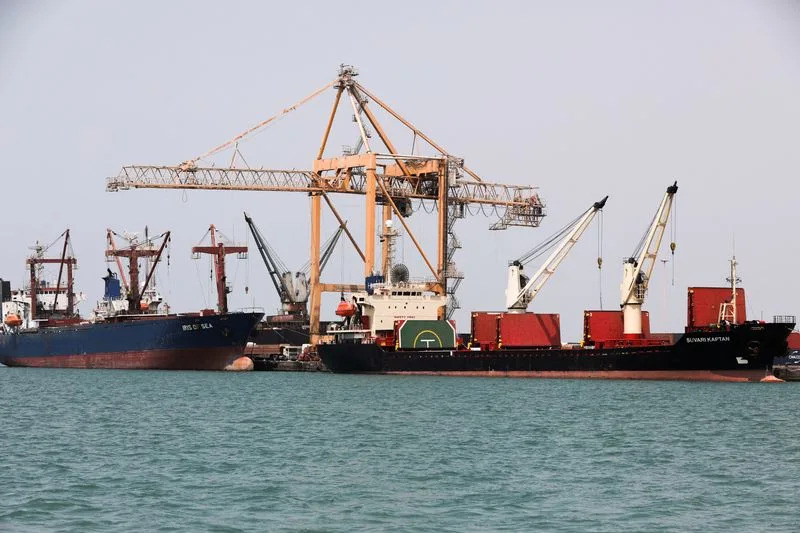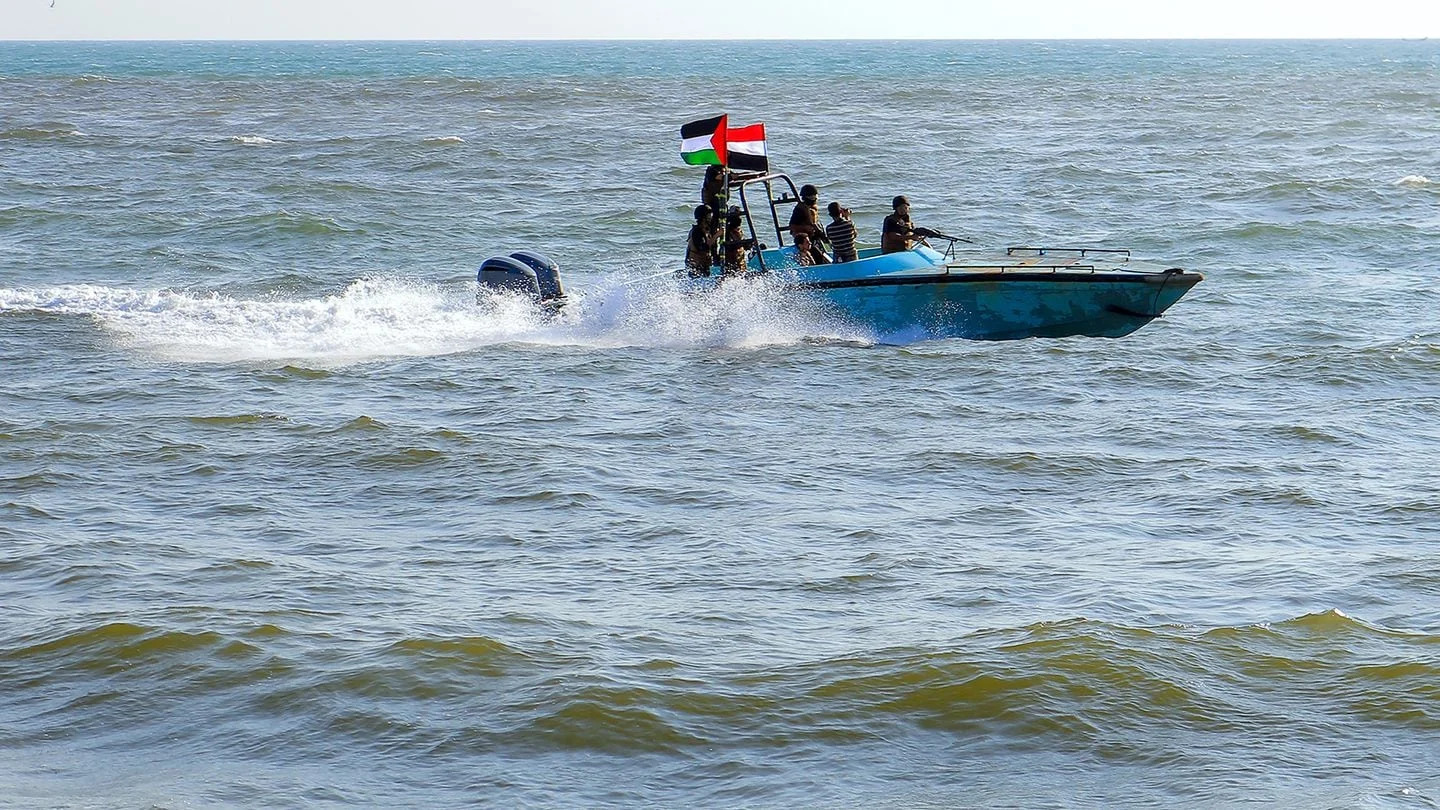Ships will have to obtain a permit from Yemen's Houthi-controlled Maritime Affairs Authority before entering Yemeni waters, Houthi Telecommunications Minister Misfer Al-Numair said on Monday.
Houthi militants have repeatedly launched drones and missiles against international commercial shipping in the Gulf of Aden since mid-November, saying they are acting in solidarity with Palestinians against Israel's offensive in Gaza.
The near-daily attacks have forced firms into long and costly diversions around southern Africa, and stoked fears that the Israel-Hamas war could destabilise the wider Middle East. The United States and Britain have bombed Houthi targets in response.
"(We) are ready to assist requests for permits and identify ships with the Yemeni Navy, and we confirm this is out of concern for their safety," Al Masirah TV, the main television news outlet run by Yemen's Iran-aligned Houthi movement, reported Al-Numair as saying.
The territorial waters affected by the Yemeni order extend halfway out into the 20-km (12-mile) wide Bab al-Mandab Strait, the narrow mouth of the Red Sea through which around 15% of the world's shipping traffic passes on its way to or from the Suez Canal.
In normal times, more than a quarter of global container cargo - including apparel, appliances, auto parts, chemicals and agricultural products like coffee - move via the Suez Canal.
Former U.S. Defense Secretary Robert Gates said there "is good reason to doubt" that the Iran-allied Houthis would stop their assaults on vessels if a ceasefire ends Israel's major military operations in Gaza.
"They may decide that they like the idea of controlling the amount of shipping going through the Red Sea, and will continue this for an indefinite period of time," Gates said at
the TPM24 container shipping conference in Long Beach, California.
Elsewhere on Monday, Hong Kong-based HGC Global Communications said that at least four underwater communications cables - Asia-Africa-Europe 1, the Europe India Gateway, Seacom and TGN-Gulf - had been damaged last week in the Red Sea, without stating the cause.
It estimated that the damage had affected 25% of the data traffic flowing under the Red Sea, and said in a statement that it had devised a plan to reroute traffic.
Al-Numair's ministry on Saturday blamed U.S. and British attacks for any damage to cables.
In the latest incident, the UK Maritime Trade Operations agency said on Monday it had received a report that a vessel had been damaged by two explosions, 91 nautical miles southeast of Aden, but there were no casualties and the vessel was proceeding to its next port of call.
Yemen has been mired in conflict since Houthis ousted the government from the capital Sanaa in late 2014. The Saudi Arabia-led military coalition intervened in 2015, aiming to restore the government.
Red Sea underwater data cables cut as Houthi attacks continue
Three Red Sea underwater cables providing internet and telecommunications around the world have been cut as the waterway remains a target of Yemen’s Houthi rebels, officials said Monday. Meanwhile, a suspected Houthi attack set a ship ablaze in the Gulf of Aden.
What cut the lines remains unclear. There has been concern about the cables being targeted in the Houthi campaign, which the rebels describe as an effort to pressure Israel to end its war on Hamas in the Gaza Strip. The Houthis have denied attacking the lines, however.
Houthi rebels present little threat to undersea cables, US admiral says
While global shipping has already been disrupted through the Red Sea, a crucial route for cargo and energy shipments from Asia and the Middle East to Europe, the sabotage of telecommunication lines could further escalate the months-long crisis.
The cut lines include Asia-Africa-Europe 1, the Europe India Gateway, Seacom and TGN-Gulf, Hong Kong-based HGC Global Communications said. It described the cuts as affecting 25% of the traffic flowing through the Red Sea. It described the Red Sea route as crucial for data moving from Asia to Europe and said it had begun rerouting traffic.
HGC Global Communications described the Seacom-TGN-Gulf line as being two separate cables when it is actually one at the area of the cut, according to Tim Stronge, a subsea cable expert with TeleGeography, a Washington-based telecommunications market research company.
Responding to questions from The Associated Press, Seacom said that “initial testing indicates the affected segment lies within Yemeni maritime jurisdictions in the Southern Red Sea.” It said it was rerouting the traffic it was able to change, though some services were down.
Tata Communications, part of the Indian conglomerate and behind the Seacom-TGN-Gulf line, told the AP it “initiated immediate and appropriate remedial actions” after the line was cut.
“We invest in various cable consortiums to increase our diversity and hence in such situations of a cable cut or snag, we are able to automatically reroute our services,” Tata said.
Other firms behind those lines, which provide data to Africa, Asia and the Middle East, did not immediately respond to queries Monday from the AP.
In early February, Yemen’s internationally recognized government in exile alleged that the Houthis planned to attack the cables. The lines appeared to have been cut on Feb. 24, with the organization NetBlocks noticing internet access in the East African nation of Djibouti suffering from interruptions two days later. Seacom serves Djibouti. There have been disruptions in Bahrain as well, a Persian Gulf island kingdom also served by the lines.
But for their part, the Houthis have denied targeting the cables. The rebels blamed the disruptions on British and U.S. military operations but did not offer evidence to support the allegation and have made false claims in the past.
“The hostilities on Yemen by the British and U.S. naval military units caused a disruption in the submarine cables in the Red Sea, which jeopardized the security and safety of international communications and the normal flow of information,” the Houthi-controlled Transportation Ministry in Yemen’s rebel-held capital, Sanaa, alleged.
Since November, the rebels have repeatedly targeted ships in the Red Sea and surrounding waters over the Israel-Hamas war. Those vessels have included at least one with cargo bound for Iran, the Houthis’ main benefactor, and an aid ship later bound for Houthi-controlled territory.
Despite more than a month and a half of U.S.-led airstrikes, Houthi rebels have remained capable of launching significant attacks. They include the attack last month on a cargo ship carrying fertilizer, the Rubymar, which sank on Saturday after drifting for several days, and the downing of an American drone worth tens of millions of dollars.
The Houthis insist their attacks will continue until Israel stops its combat operations in the Gaza Strip, which have enraged the wider Arab world and seen the Houthis gain international recognition.
Meanwhile, the British military’s United Kingdom Maritime Trade Operations center on Monday separately warned of a new attack in the Gulf of Aden. The private security firm Ambrey described the vessel targeted as a Liberia-flagged, Israel-affiliated container ship that sustained damage and issued a distress call.
“The container ship reportedly encountered two explosions of which the first occurred at a ‘distance’ off its port quarter, while the second damaged the vessel’s accommodation block and a container leading,” Ambrey said. “The explosion further led to a fire onboard and the crew’s firefighting efforts were underway.”
Ambrey said no crew member on the ship had been injured. The U.S. Navy’s 5th Fleet, which patrols the Mideast, did not immediately respond to questions about the attack.
The Houthis did not immediately claim the attack, but it typically takes them several hours before they acknowledge an assault.
It remains unclear how the Houthis could attack subsea cables themselves. The rebels are not known to have the diving or salvage capability to target the lines, which sit hundreds of meters (feet) below the surface of the waterway.
However, subsea cables can be cut by anchors, including those dropped from some of the ships that have been disabled in attacks. A drifting ship with its anchor scraping the sea could be the culprit.
“Our team thinks it is plausible that it could have been affected by anchor dragging, due to the amount of marine traffic the region deals with and the low seabed in many parts of the Red Sea,” Seacom said. “This can only be confirmed once the repair ship is on site.”
There are 14 cables now running through the Red Sea, with another six planned, Stronge, the subsea cable expert, said.
“We estimate that over 90% of communications between Europe and Asia traverse submarine cables in the Red Sea,” he said. “Fortunately, telecom operators have built a high degree of redundancy into the system — there are many cables traversing the Red Sea.”




